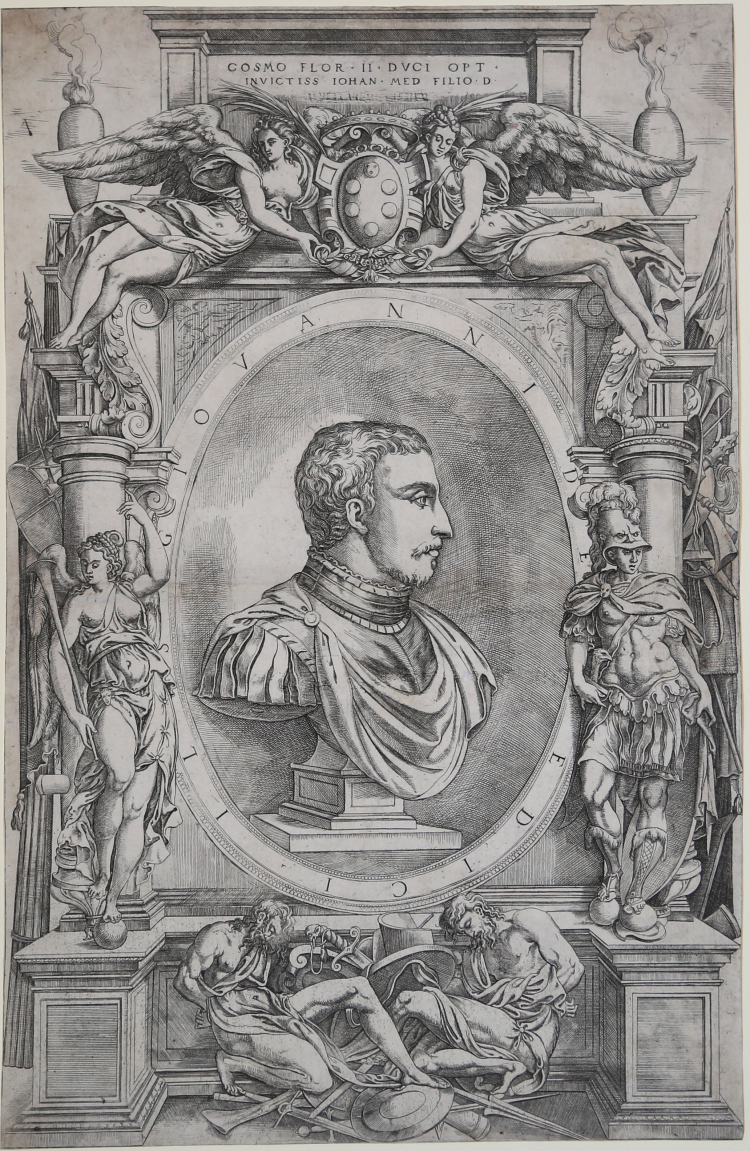



| Reference: | S32384 |
| Author | Enea VICO |
| Year: | 1550 ca. |
| Measures: | 304 x 472 mm |


| Reference: | S32384 |
| Author | Enea VICO |
| Year: | 1550 ca. |
| Measures: | 304 x 472 mm |
Engraving, 1550, signed at the upper center and dated at the lower right.
Example in the first state, of two, before the Lafrery’s address at lower right corner.
A very good impression of this rare work, printed on contemporary laid paper with “arch in the circle with fleur-de-lis” (Briquet 760), trimmed to the platemark, traces of central folds, generally in very good condition.
Giovanni de Medici, son of Lorenzo The Magnificent, was elected pope in 1513 with the name of Leone X. The portrait was commissioned to Vico by Cosimo II de Medici, as the dedication demonstrates.
|
Bartsch 254 (stato unico).
|
Enea VICO (Parma 1523 - Ferrara 1567)
|
Enea, son of Francesco, was antique dealer, drawer, engraver and numismatist. He was born in Parma on January 29th, 1523, according to what Huber says. After the first school years in the city, and very likely after he made acquaintance with the works of Giulio Romano, Vico moved to Rome in 1541. He then worked for Tommaso Barlacchi, who also engraved with him a series of Grottesche, in 1542. In the classical atmosphere of Rome, Vico’s style developed according to that of Perin del Vaga and Francesco Salviati, but always with Parmigianino as main reference. Around the first half of the century and after studying the works of Marcantonio, Agostino Veneziano, Caraglio and Bonasone, Vico acquired his own, peculiar style which can be seen in his main works. From Rome Vico moved to Florence, where he worked for Cosimo I, and then went to Venice, in 1557. In 1563 he is already in Ferrara, working for Alfonso d’Este till his death in 1567.
|
|
Bartsch 254 (stato unico).
|
Enea VICO (Parma 1523 - Ferrara 1567)
|
Enea, son of Francesco, was antique dealer, drawer, engraver and numismatist. He was born in Parma on January 29th, 1523, according to what Huber says. After the first school years in the city, and very likely after he made acquaintance with the works of Giulio Romano, Vico moved to Rome in 1541. He then worked for Tommaso Barlacchi, who also engraved with him a series of Grottesche, in 1542. In the classical atmosphere of Rome, Vico’s style developed according to that of Perin del Vaga and Francesco Salviati, but always with Parmigianino as main reference. Around the first half of the century and after studying the works of Marcantonio, Agostino Veneziano, Caraglio and Bonasone, Vico acquired his own, peculiar style which can be seen in his main works. From Rome Vico moved to Florence, where he worked for Cosimo I, and then went to Venice, in 1557. In 1563 he is already in Ferrara, working for Alfonso d’Este till his death in 1567.
|